Analysis of Firm Valuation and Forecasting in Finance and Investment
VerifiedAdded on 2022/09/01
|10
|2832
|15
Report
AI Summary
This report delves into the valuation of a firm, exploring both book value and market value approaches, with a primary focus on the Discounted Cash Flow (DCF) technique. It elucidates the calculation of market value, its relation to equity, and the factors influencing its stability, contrasting large versus small organizations. The report further examines forecasting methods, differentiating between qualitative and quantitative models, and detailing techniques like indicator approaches and econometric modeling. It outlines the steps involved in the forecasting process, from data selection to model verification, and concludes by acknowledging the inherent challenges in forecasting while emphasizing its importance for business planning and risk assessment. The report provides formulas for key financial metrics like FCFF, WACC, and COE.
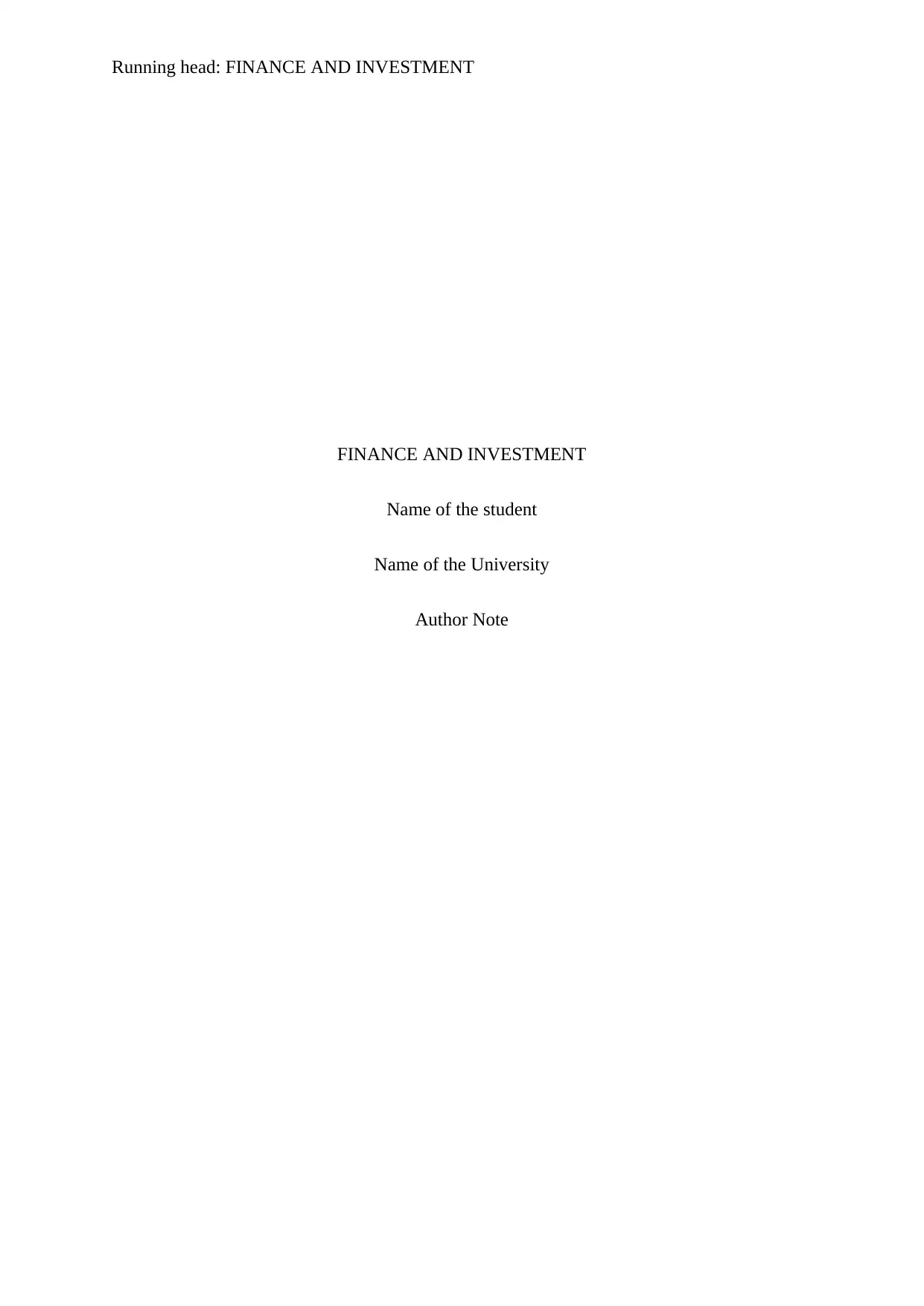
Running head: FINANCE AND INVESTMENT
FINANCE AND INVESTMENT
Name of the student
Name of the University
Author Note
FINANCE AND INVESTMENT
Name of the student
Name of the University
Author Note
Paraphrase This Document
Need a fresh take? Get an instant paraphrase of this document with our AI Paraphraser
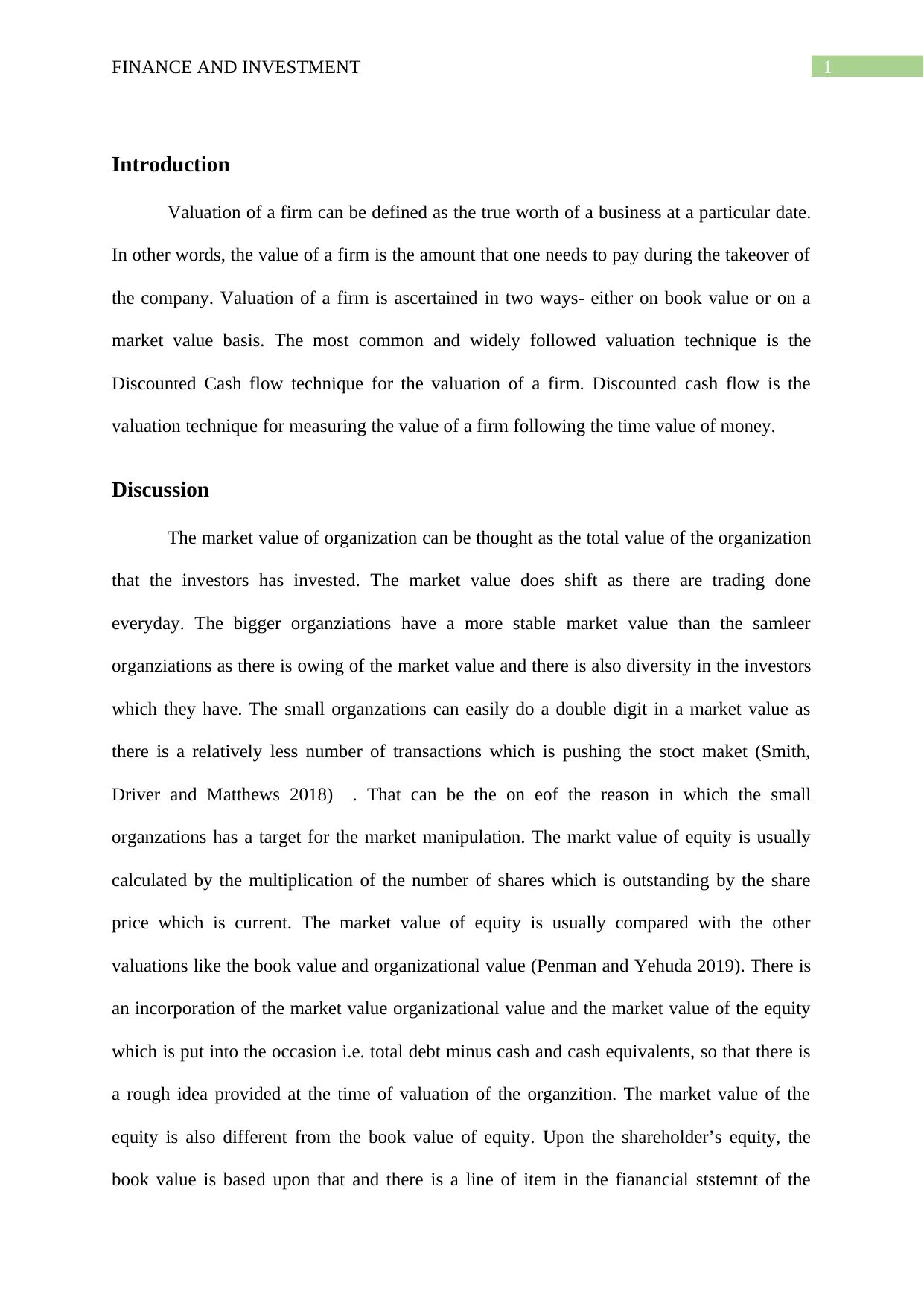
1FINANCE AND INVESTMENT
Introduction
Valuation of a firm can be defined as the true worth of a business at a particular date.
In other words, the value of a firm is the amount that one needs to pay during the takeover of
the company. Valuation of a firm is ascertained in two ways- either on book value or on a
market value basis. The most common and widely followed valuation technique is the
Discounted Cash flow technique for the valuation of a firm. Discounted cash flow is the
valuation technique for measuring the value of a firm following the time value of money.
Discussion
The market value of organization can be thought as the total value of the organization
that the investors has invested. The market value does shift as there are trading done
everyday. The bigger organziations have a more stable market value than the samleer
organziations as there is owing of the market value and there is also diversity in the investors
which they have. The small organzations can easily do a double digit in a market value as
there is a relatively less number of transactions which is pushing the stoct maket (Smith,
Driver and Matthews 2018) . That can be the on eof the reason in which the small
organzations has a target for the market manipulation. The markt value of equity is usually
calculated by the multiplication of the number of shares which is outstanding by the share
price which is current. The market value of equity is usually compared with the other
valuations like the book value and organizational value (Penman and Yehuda 2019). There is
an incorporation of the market value organizational value and the market value of the equity
which is put into the occasion i.e. total debt minus cash and cash equivalents, so that there is
a rough idea provided at the time of valuation of the organzition. The market value of the
equity is also different from the book value of equity. Upon the shareholder’s equity, the
book value is based upon that and there is a line of item in the fianancial ststemnt of the
Introduction
Valuation of a firm can be defined as the true worth of a business at a particular date.
In other words, the value of a firm is the amount that one needs to pay during the takeover of
the company. Valuation of a firm is ascertained in two ways- either on book value or on a
market value basis. The most common and widely followed valuation technique is the
Discounted Cash flow technique for the valuation of a firm. Discounted cash flow is the
valuation technique for measuring the value of a firm following the time value of money.
Discussion
The market value of organization can be thought as the total value of the organization
that the investors has invested. The market value does shift as there are trading done
everyday. The bigger organziations have a more stable market value than the samleer
organziations as there is owing of the market value and there is also diversity in the investors
which they have. The small organzations can easily do a double digit in a market value as
there is a relatively less number of transactions which is pushing the stoct maket (Smith,
Driver and Matthews 2018) . That can be the on eof the reason in which the small
organzations has a target for the market manipulation. The markt value of equity is usually
calculated by the multiplication of the number of shares which is outstanding by the share
price which is current. The market value of equity is usually compared with the other
valuations like the book value and organizational value (Penman and Yehuda 2019). There is
an incorporation of the market value organizational value and the market value of the equity
which is put into the occasion i.e. total debt minus cash and cash equivalents, so that there is
a rough idea provided at the time of valuation of the organzition. The market value of the
equity is also different from the book value of equity. Upon the shareholder’s equity, the
book value is based upon that and there is a line of item in the fianancial ststemnt of the
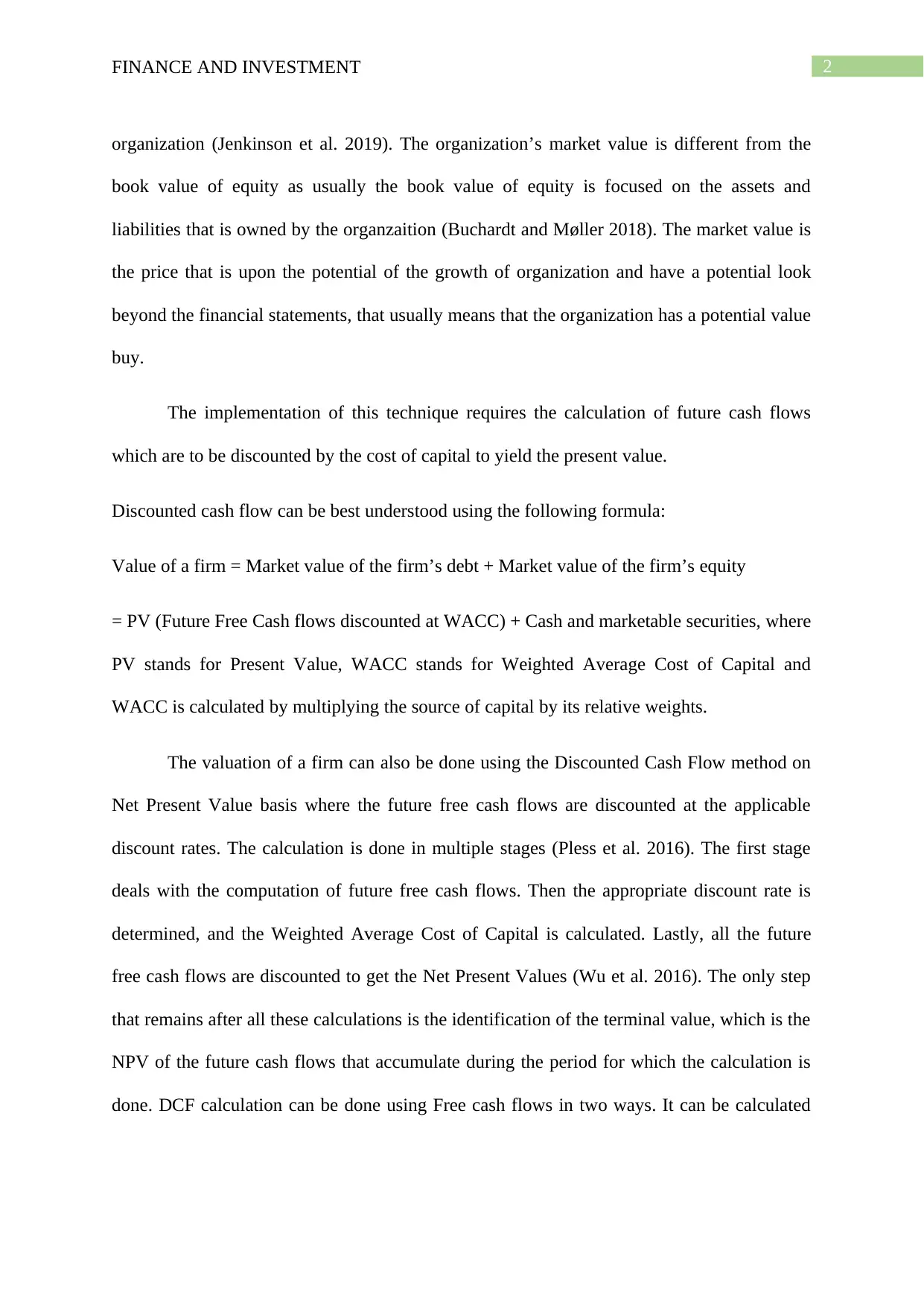
2FINANCE AND INVESTMENT
organization (Jenkinson et al. 2019). The organization’s market value is different from the
book value of equity as usually the book value of equity is focused on the assets and
liabilities that is owned by the organzaition (Buchardt and Møller 2018). The market value is
the price that is upon the potential of the growth of organization and have a potential look
beyond the financial statements, that usually means that the organization has a potential value
buy.
The implementation of this technique requires the calculation of future cash flows
which are to be discounted by the cost of capital to yield the present value.
Discounted cash flow can be best understood using the following formula:
Value of a firm = Market value of the firm’s debt + Market value of the firm’s equity
= PV (Future Free Cash flows discounted at WACC) + Cash and marketable securities, where
PV stands for Present Value, WACC stands for Weighted Average Cost of Capital and
WACC is calculated by multiplying the source of capital by its relative weights.
The valuation of a firm can also be done using the Discounted Cash Flow method on
Net Present Value basis where the future free cash flows are discounted at the applicable
discount rates. The calculation is done in multiple stages (Pless et al. 2016). The first stage
deals with the computation of future free cash flows. Then the appropriate discount rate is
determined, and the Weighted Average Cost of Capital is calculated. Lastly, all the future
free cash flows are discounted to get the Net Present Values (Wu et al. 2016). The only step
that remains after all these calculations is the identification of the terminal value, which is the
NPV of the future cash flows that accumulate during the period for which the calculation is
done. DCF calculation can be done using Free cash flows in two ways. It can be calculated
organization (Jenkinson et al. 2019). The organization’s market value is different from the
book value of equity as usually the book value of equity is focused on the assets and
liabilities that is owned by the organzaition (Buchardt and Møller 2018). The market value is
the price that is upon the potential of the growth of organization and have a potential look
beyond the financial statements, that usually means that the organization has a potential value
buy.
The implementation of this technique requires the calculation of future cash flows
which are to be discounted by the cost of capital to yield the present value.
Discounted cash flow can be best understood using the following formula:
Value of a firm = Market value of the firm’s debt + Market value of the firm’s equity
= PV (Future Free Cash flows discounted at WACC) + Cash and marketable securities, where
PV stands for Present Value, WACC stands for Weighted Average Cost of Capital and
WACC is calculated by multiplying the source of capital by its relative weights.
The valuation of a firm can also be done using the Discounted Cash Flow method on
Net Present Value basis where the future free cash flows are discounted at the applicable
discount rates. The calculation is done in multiple stages (Pless et al. 2016). The first stage
deals with the computation of future free cash flows. Then the appropriate discount rate is
determined, and the Weighted Average Cost of Capital is calculated. Lastly, all the future
free cash flows are discounted to get the Net Present Values (Wu et al. 2016). The only step
that remains after all these calculations is the identification of the terminal value, which is the
NPV of the future cash flows that accumulate during the period for which the calculation is
done. DCF calculation can be done using Free cash flows in two ways. It can be calculated
⊘ This is a preview!⊘
Do you want full access?
Subscribe today to unlock all pages.

Trusted by 1+ million students worldwide
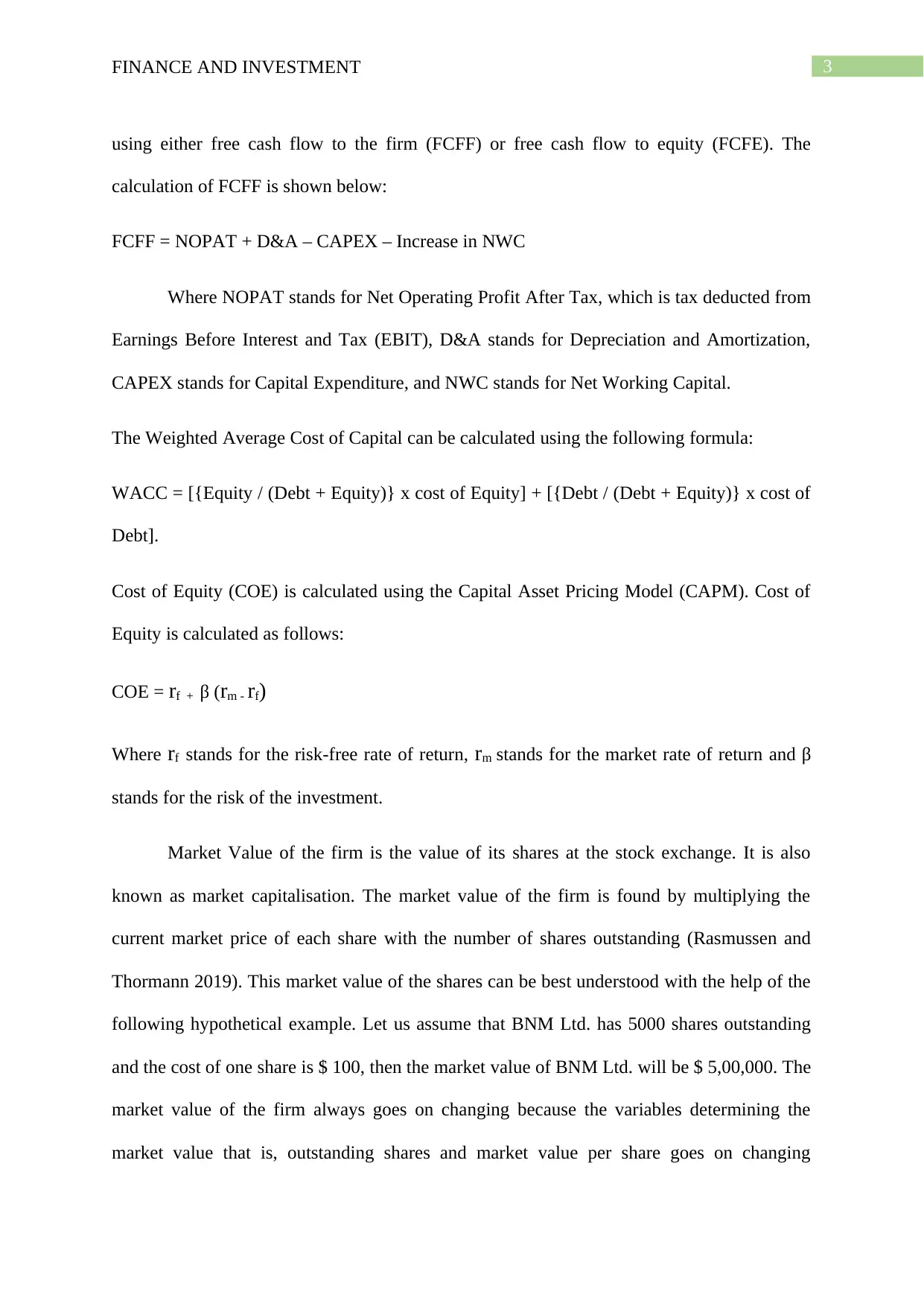
3FINANCE AND INVESTMENT
using either free cash flow to the firm (FCFF) or free cash flow to equity (FCFE). The
calculation of FCFF is shown below:
FCFF = NOPAT + D&A – CAPEX – Increase in NWC
Where NOPAT stands for Net Operating Profit After Tax, which is tax deducted from
Earnings Before Interest and Tax (EBIT), D&A stands for Depreciation and Amortization,
CAPEX stands for Capital Expenditure, and NWC stands for Net Working Capital.
The Weighted Average Cost of Capital can be calculated using the following formula:
WACC = [{Equity / (Debt + Equity)} x cost of Equity] + [{Debt / (Debt + Equity)} x cost of
Debt].
Cost of Equity (COE) is calculated using the Capital Asset Pricing Model (CAPM). Cost of
Equity is calculated as follows:
COE = rf + β (rm - rf)
Where rf stands for the risk-free rate of return, rm stands for the market rate of return and β
stands for the risk of the investment.
Market Value of the firm is the value of its shares at the stock exchange. It is also
known as market capitalisation. The market value of the firm is found by multiplying the
current market price of each share with the number of shares outstanding (Rasmussen and
Thormann 2019). This market value of the shares can be best understood with the help of the
following hypothetical example. Let us assume that BNM Ltd. has 5000 shares outstanding
and the cost of one share is $ 100, then the market value of BNM Ltd. will be $ 5,00,000. The
market value of the firm always goes on changing because the variables determining the
market value that is, outstanding shares and market value per share goes on changing
using either free cash flow to the firm (FCFF) or free cash flow to equity (FCFE). The
calculation of FCFF is shown below:
FCFF = NOPAT + D&A – CAPEX – Increase in NWC
Where NOPAT stands for Net Operating Profit After Tax, which is tax deducted from
Earnings Before Interest and Tax (EBIT), D&A stands for Depreciation and Amortization,
CAPEX stands for Capital Expenditure, and NWC stands for Net Working Capital.
The Weighted Average Cost of Capital can be calculated using the following formula:
WACC = [{Equity / (Debt + Equity)} x cost of Equity] + [{Debt / (Debt + Equity)} x cost of
Debt].
Cost of Equity (COE) is calculated using the Capital Asset Pricing Model (CAPM). Cost of
Equity is calculated as follows:
COE = rf + β (rm - rf)
Where rf stands for the risk-free rate of return, rm stands for the market rate of return and β
stands for the risk of the investment.
Market Value of the firm is the value of its shares at the stock exchange. It is also
known as market capitalisation. The market value of the firm is found by multiplying the
current market price of each share with the number of shares outstanding (Rasmussen and
Thormann 2019). This market value of the shares can be best understood with the help of the
following hypothetical example. Let us assume that BNM Ltd. has 5000 shares outstanding
and the cost of one share is $ 100, then the market value of BNM Ltd. will be $ 5,00,000. The
market value of the firm always goes on changing because the variables determining the
market value that is, outstanding shares and market value per share goes on changing
Paraphrase This Document
Need a fresh take? Get an instant paraphrase of this document with our AI Paraphraser
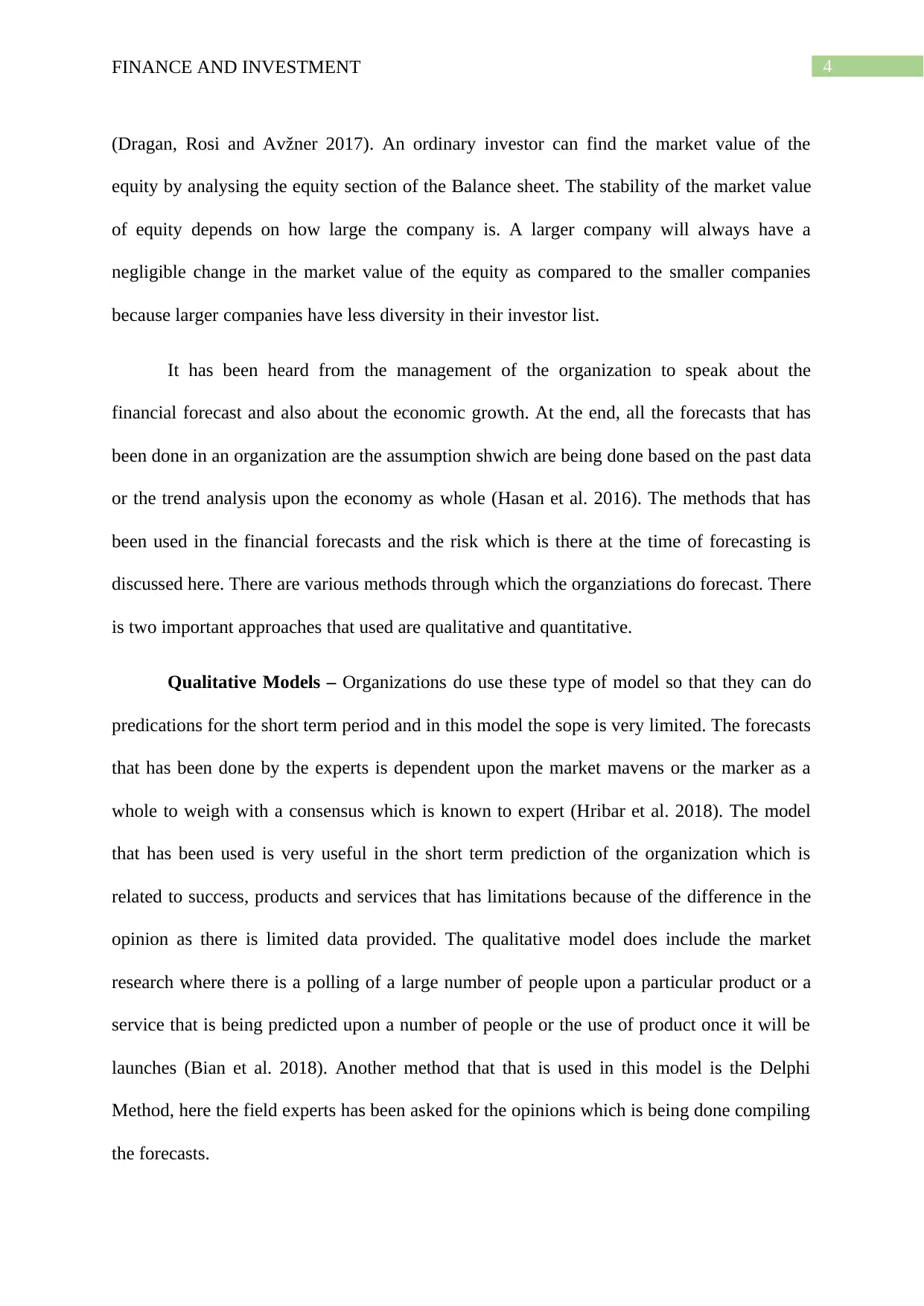
4FINANCE AND INVESTMENT
(Dragan, Rosi and Avžner 2017). An ordinary investor can find the market value of the
equity by analysing the equity section of the Balance sheet. The stability of the market value
of equity depends on how large the company is. A larger company will always have a
negligible change in the market value of the equity as compared to the smaller companies
because larger companies have less diversity in their investor list.
It has been heard from the management of the organization to speak about the
financial forecast and also about the economic growth. At the end, all the forecasts that has
been done in an organization are the assumption shwich are being done based on the past data
or the trend analysis upon the economy as whole (Hasan et al. 2016). The methods that has
been used in the financial forecasts and the risk which is there at the time of forecasting is
discussed here. There are various methods through which the organziations do forecast. There
is two important approaches that used are qualitative and quantitative.
Qualitative Models – Organizations do use these type of model so that they can do
predications for the short term period and in this model the sope is very limited. The forecasts
that has been done by the experts is dependent upon the market mavens or the marker as a
whole to weigh with a consensus which is known to expert (Hribar et al. 2018). The model
that has been used is very useful in the short term prediction of the organization which is
related to success, products and services that has limitations because of the difference in the
opinion as there is limited data provided. The qualitative model does include the market
research where there is a polling of a large number of people upon a particular product or a
service that is being predicted upon a number of people or the use of product once it will be
launches (Bian et al. 2018). Another method that that is used in this model is the Delphi
Method, here the field experts has been asked for the opinions which is being done compiling
the forecasts.
(Dragan, Rosi and Avžner 2017). An ordinary investor can find the market value of the
equity by analysing the equity section of the Balance sheet. The stability of the market value
of equity depends on how large the company is. A larger company will always have a
negligible change in the market value of the equity as compared to the smaller companies
because larger companies have less diversity in their investor list.
It has been heard from the management of the organization to speak about the
financial forecast and also about the economic growth. At the end, all the forecasts that has
been done in an organization are the assumption shwich are being done based on the past data
or the trend analysis upon the economy as whole (Hasan et al. 2016). The methods that has
been used in the financial forecasts and the risk which is there at the time of forecasting is
discussed here. There are various methods through which the organziations do forecast. There
is two important approaches that used are qualitative and quantitative.
Qualitative Models – Organizations do use these type of model so that they can do
predications for the short term period and in this model the sope is very limited. The forecasts
that has been done by the experts is dependent upon the market mavens or the marker as a
whole to weigh with a consensus which is known to expert (Hribar et al. 2018). The model
that has been used is very useful in the short term prediction of the organization which is
related to success, products and services that has limitations because of the difference in the
opinion as there is limited data provided. The qualitative model does include the market
research where there is a polling of a large number of people upon a particular product or a
service that is being predicted upon a number of people or the use of product once it will be
launches (Bian et al. 2018). Another method that that is used in this model is the Delphi
Method, here the field experts has been asked for the opinions which is being done compiling
the forecasts.
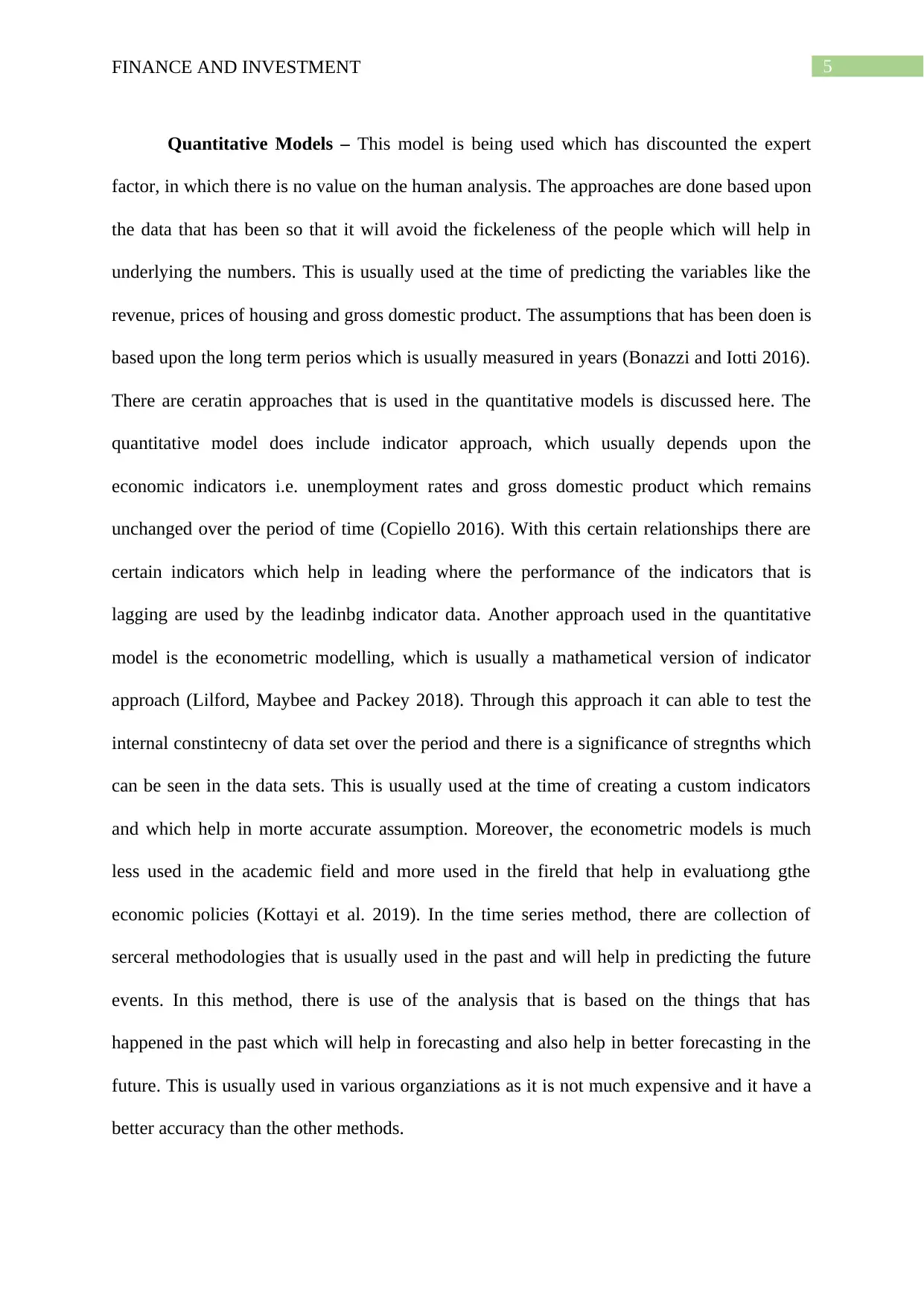
5FINANCE AND INVESTMENT
Quantitative Models – This model is being used which has discounted the expert
factor, in which there is no value on the human analysis. The approaches are done based upon
the data that has been so that it will avoid the fickeleness of the people which will help in
underlying the numbers. This is usually used at the time of predicting the variables like the
revenue, prices of housing and gross domestic product. The assumptions that has been doen is
based upon the long term perios which is usually measured in years (Bonazzi and Iotti 2016).
There are ceratin approaches that is used in the quantitative models is discussed here. The
quantitative model does include indicator approach, which usually depends upon the
economic indicators i.e. unemployment rates and gross domestic product which remains
unchanged over the period of time (Copiello 2016). With this certain relationships there are
certain indicators which help in leading where the performance of the indicators that is
lagging are used by the leadinbg indicator data. Another approach used in the quantitative
model is the econometric modelling, which is usually a mathametical version of indicator
approach (Lilford, Maybee and Packey 2018). Through this approach it can able to test the
internal constintecny of data set over the period and there is a significance of stregnths which
can be seen in the data sets. This is usually used at the time of creating a custom indicators
and which help in morte accurate assumption. Moreover, the econometric models is much
less used in the academic field and more used in the fireld that help in evaluationg gthe
economic policies (Kottayi et al. 2019). In the time series method, there are collection of
serceral methodologies that is usually used in the past and will help in predicting the future
events. In this method, there is use of the analysis that is based on the things that has
happened in the past which will help in forecasting and also help in better forecasting in the
future. This is usually used in various organziations as it is not much expensive and it have a
better accuracy than the other methods.
Quantitative Models – This model is being used which has discounted the expert
factor, in which there is no value on the human analysis. The approaches are done based upon
the data that has been so that it will avoid the fickeleness of the people which will help in
underlying the numbers. This is usually used at the time of predicting the variables like the
revenue, prices of housing and gross domestic product. The assumptions that has been doen is
based upon the long term perios which is usually measured in years (Bonazzi and Iotti 2016).
There are ceratin approaches that is used in the quantitative models is discussed here. The
quantitative model does include indicator approach, which usually depends upon the
economic indicators i.e. unemployment rates and gross domestic product which remains
unchanged over the period of time (Copiello 2016). With this certain relationships there are
certain indicators which help in leading where the performance of the indicators that is
lagging are used by the leadinbg indicator data. Another approach used in the quantitative
model is the econometric modelling, which is usually a mathametical version of indicator
approach (Lilford, Maybee and Packey 2018). Through this approach it can able to test the
internal constintecny of data set over the period and there is a significance of stregnths which
can be seen in the data sets. This is usually used at the time of creating a custom indicators
and which help in morte accurate assumption. Moreover, the econometric models is much
less used in the academic field and more used in the fireld that help in evaluationg gthe
economic policies (Kottayi et al. 2019). In the time series method, there are collection of
serceral methodologies that is usually used in the past and will help in predicting the future
events. In this method, there is use of the analysis that is based on the things that has
happened in the past which will help in forecasting and also help in better forecasting in the
future. This is usually used in various organziations as it is not much expensive and it have a
better accuracy than the other methods.
⊘ This is a preview!⊘
Do you want full access?
Subscribe today to unlock all pages.

Trusted by 1+ million students worldwide
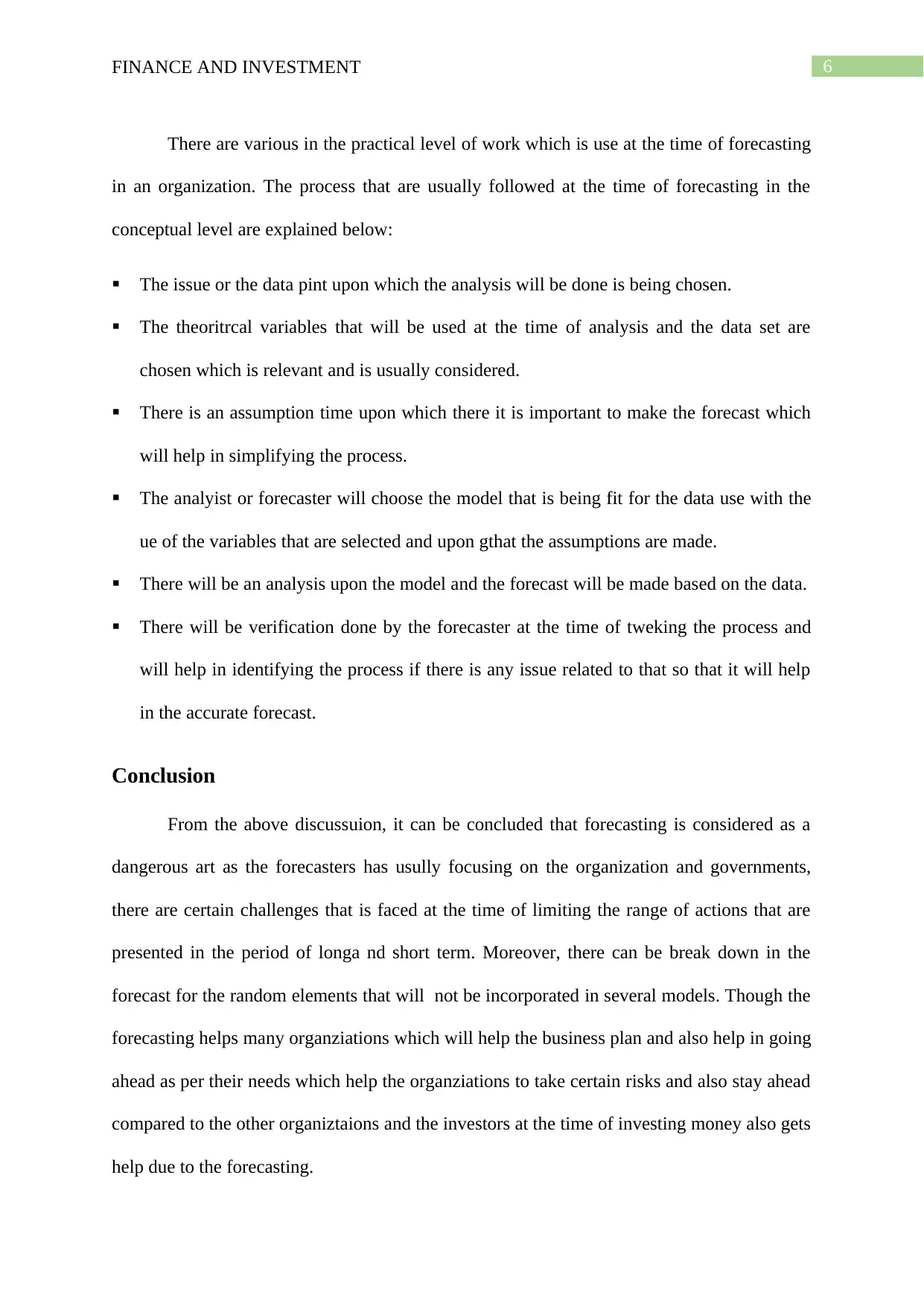
6FINANCE AND INVESTMENT
There are various in the practical level of work which is use at the time of forecasting
in an organization. The process that are usually followed at the time of forecasting in the
conceptual level are explained below:
The issue or the data pint upon which the analysis will be done is being chosen.
The theoritrcal variables that will be used at the time of analysis and the data set are
chosen which is relevant and is usually considered.
There is an assumption time upon which there it is important to make the forecast which
will help in simplifying the process.
The analyist or forecaster will choose the model that is being fit for the data use with the
ue of the variables that are selected and upon gthat the assumptions are made.
There will be an analysis upon the model and the forecast will be made based on the data.
There will be verification done by the forecaster at the time of tweking the process and
will help in identifying the process if there is any issue related to that so that it will help
in the accurate forecast.
Conclusion
From the above discussuion, it can be concluded that forecasting is considered as a
dangerous art as the forecasters has usully focusing on the organization and governments,
there are certain challenges that is faced at the time of limiting the range of actions that are
presented in the period of longa nd short term. Moreover, there can be break down in the
forecast for the random elements that will not be incorporated in several models. Though the
forecasting helps many organziations which will help the business plan and also help in going
ahead as per their needs which help the organziations to take certain risks and also stay ahead
compared to the other organiztaions and the investors at the time of investing money also gets
help due to the forecasting.
There are various in the practical level of work which is use at the time of forecasting
in an organization. The process that are usually followed at the time of forecasting in the
conceptual level are explained below:
The issue or the data pint upon which the analysis will be done is being chosen.
The theoritrcal variables that will be used at the time of analysis and the data set are
chosen which is relevant and is usually considered.
There is an assumption time upon which there it is important to make the forecast which
will help in simplifying the process.
The analyist or forecaster will choose the model that is being fit for the data use with the
ue of the variables that are selected and upon gthat the assumptions are made.
There will be an analysis upon the model and the forecast will be made based on the data.
There will be verification done by the forecaster at the time of tweking the process and
will help in identifying the process if there is any issue related to that so that it will help
in the accurate forecast.
Conclusion
From the above discussuion, it can be concluded that forecasting is considered as a
dangerous art as the forecasters has usully focusing on the organization and governments,
there are certain challenges that is faced at the time of limiting the range of actions that are
presented in the period of longa nd short term. Moreover, there can be break down in the
forecast for the random elements that will not be incorporated in several models. Though the
forecasting helps many organziations which will help the business plan and also help in going
ahead as per their needs which help the organziations to take certain risks and also stay ahead
compared to the other organiztaions and the investors at the time of investing money also gets
help due to the forecasting.
Paraphrase This Document
Need a fresh take? Get an instant paraphrase of this document with our AI Paraphraser

7FINANCE AND INVESTMENT
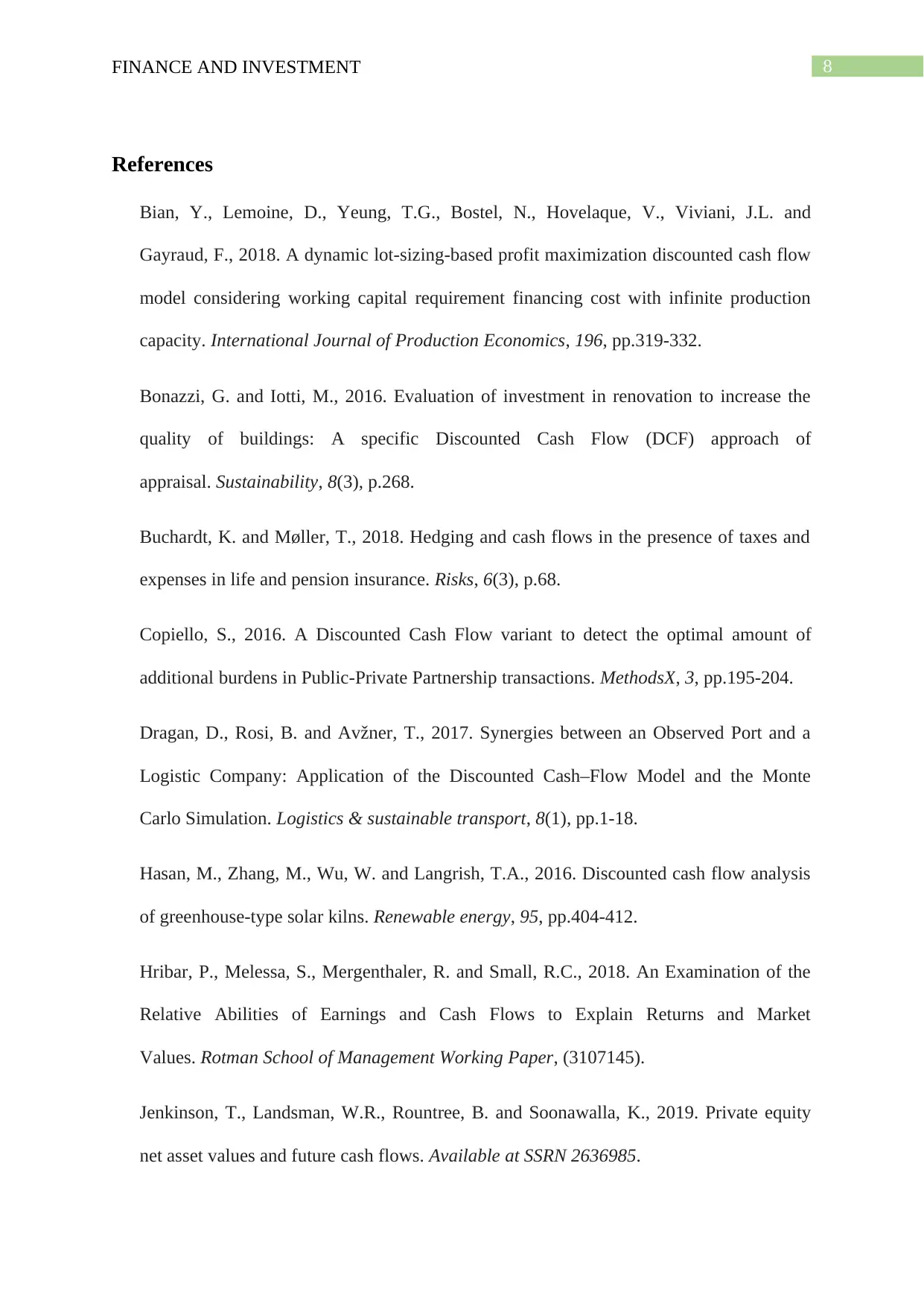
8FINANCE AND INVESTMENT
References
Bian, Y., Lemoine, D., Yeung, T.G., Bostel, N., Hovelaque, V., Viviani, J.L. and
Gayraud, F., 2018. A dynamic lot-sizing-based profit maximization discounted cash flow
model considering working capital requirement financing cost with infinite production
capacity. International Journal of Production Economics, 196, pp.319-332.
Bonazzi, G. and Iotti, M., 2016. Evaluation of investment in renovation to increase the
quality of buildings: A specific Discounted Cash Flow (DCF) approach of
appraisal. Sustainability, 8(3), p.268.
Buchardt, K. and Møller, T., 2018. Hedging and cash flows in the presence of taxes and
expenses in life and pension insurance. Risks, 6(3), p.68.
Copiello, S., 2016. A Discounted Cash Flow variant to detect the optimal amount of
additional burdens in Public-Private Partnership transactions. MethodsX, 3, pp.195-204.
Dragan, D., Rosi, B. and Avžner, T., 2017. Synergies between an Observed Port and a
Logistic Company: Application of the Discounted Cash–Flow Model and the Monte
Carlo Simulation. Logistics & sustainable transport, 8(1), pp.1-18.
Hasan, M., Zhang, M., Wu, W. and Langrish, T.A., 2016. Discounted cash flow analysis
of greenhouse-type solar kilns. Renewable energy, 95, pp.404-412.
Hribar, P., Melessa, S., Mergenthaler, R. and Small, R.C., 2018. An Examination of the
Relative Abilities of Earnings and Cash Flows to Explain Returns and Market
Values. Rotman School of Management Working Paper, (3107145).
Jenkinson, T., Landsman, W.R., Rountree, B. and Soonawalla, K., 2019. Private equity
net asset values and future cash flows. Available at SSRN 2636985.
References
Bian, Y., Lemoine, D., Yeung, T.G., Bostel, N., Hovelaque, V., Viviani, J.L. and
Gayraud, F., 2018. A dynamic lot-sizing-based profit maximization discounted cash flow
model considering working capital requirement financing cost with infinite production
capacity. International Journal of Production Economics, 196, pp.319-332.
Bonazzi, G. and Iotti, M., 2016. Evaluation of investment in renovation to increase the
quality of buildings: A specific Discounted Cash Flow (DCF) approach of
appraisal. Sustainability, 8(3), p.268.
Buchardt, K. and Møller, T., 2018. Hedging and cash flows in the presence of taxes and
expenses in life and pension insurance. Risks, 6(3), p.68.
Copiello, S., 2016. A Discounted Cash Flow variant to detect the optimal amount of
additional burdens in Public-Private Partnership transactions. MethodsX, 3, pp.195-204.
Dragan, D., Rosi, B. and Avžner, T., 2017. Synergies between an Observed Port and a
Logistic Company: Application of the Discounted Cash–Flow Model and the Monte
Carlo Simulation. Logistics & sustainable transport, 8(1), pp.1-18.
Hasan, M., Zhang, M., Wu, W. and Langrish, T.A., 2016. Discounted cash flow analysis
of greenhouse-type solar kilns. Renewable energy, 95, pp.404-412.
Hribar, P., Melessa, S., Mergenthaler, R. and Small, R.C., 2018. An Examination of the
Relative Abilities of Earnings and Cash Flows to Explain Returns and Market
Values. Rotman School of Management Working Paper, (3107145).
Jenkinson, T., Landsman, W.R., Rountree, B. and Soonawalla, K., 2019. Private equity
net asset values and future cash flows. Available at SSRN 2636985.
⊘ This is a preview!⊘
Do you want full access?
Subscribe today to unlock all pages.

Trusted by 1+ million students worldwide
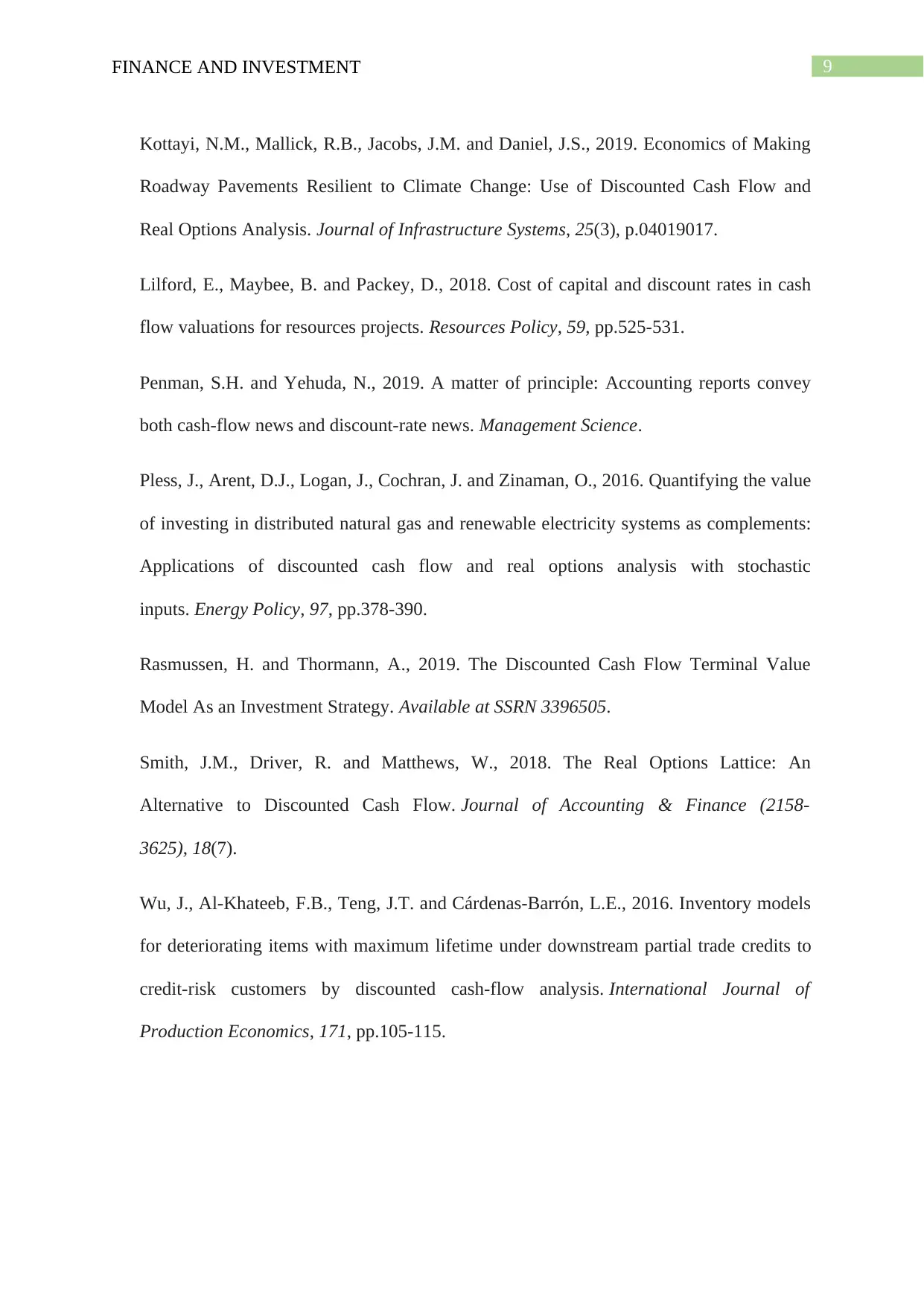
9FINANCE AND INVESTMENT
Kottayi, N.M., Mallick, R.B., Jacobs, J.M. and Daniel, J.S., 2019. Economics of Making
Roadway Pavements Resilient to Climate Change: Use of Discounted Cash Flow and
Real Options Analysis. Journal of Infrastructure Systems, 25(3), p.04019017.
Lilford, E., Maybee, B. and Packey, D., 2018. Cost of capital and discount rates in cash
flow valuations for resources projects. Resources Policy, 59, pp.525-531.
Penman, S.H. and Yehuda, N., 2019. A matter of principle: Accounting reports convey
both cash-flow news and discount-rate news. Management Science.
Pless, J., Arent, D.J., Logan, J., Cochran, J. and Zinaman, O., 2016. Quantifying the value
of investing in distributed natural gas and renewable electricity systems as complements:
Applications of discounted cash flow and real options analysis with stochastic
inputs. Energy Policy, 97, pp.378-390.
Rasmussen, H. and Thormann, A., 2019. The Discounted Cash Flow Terminal Value
Model As an Investment Strategy. Available at SSRN 3396505.
Smith, J.M., Driver, R. and Matthews, W., 2018. The Real Options Lattice: An
Alternative to Discounted Cash Flow. Journal of Accounting & Finance (2158-
3625), 18(7).
Wu, J., Al-Khateeb, F.B., Teng, J.T. and Cárdenas-Barrón, L.E., 2016. Inventory models
for deteriorating items with maximum lifetime under downstream partial trade credits to
credit-risk customers by discounted cash-flow analysis. International Journal of
Production Economics, 171, pp.105-115.
Kottayi, N.M., Mallick, R.B., Jacobs, J.M. and Daniel, J.S., 2019. Economics of Making
Roadway Pavements Resilient to Climate Change: Use of Discounted Cash Flow and
Real Options Analysis. Journal of Infrastructure Systems, 25(3), p.04019017.
Lilford, E., Maybee, B. and Packey, D., 2018. Cost of capital and discount rates in cash
flow valuations for resources projects. Resources Policy, 59, pp.525-531.
Penman, S.H. and Yehuda, N., 2019. A matter of principle: Accounting reports convey
both cash-flow news and discount-rate news. Management Science.
Pless, J., Arent, D.J., Logan, J., Cochran, J. and Zinaman, O., 2016. Quantifying the value
of investing in distributed natural gas and renewable electricity systems as complements:
Applications of discounted cash flow and real options analysis with stochastic
inputs. Energy Policy, 97, pp.378-390.
Rasmussen, H. and Thormann, A., 2019. The Discounted Cash Flow Terminal Value
Model As an Investment Strategy. Available at SSRN 3396505.
Smith, J.M., Driver, R. and Matthews, W., 2018. The Real Options Lattice: An
Alternative to Discounted Cash Flow. Journal of Accounting & Finance (2158-
3625), 18(7).
Wu, J., Al-Khateeb, F.B., Teng, J.T. and Cárdenas-Barrón, L.E., 2016. Inventory models
for deteriorating items with maximum lifetime under downstream partial trade credits to
credit-risk customers by discounted cash-flow analysis. International Journal of
Production Economics, 171, pp.105-115.
1 out of 10
Related Documents
Your All-in-One AI-Powered Toolkit for Academic Success.
+13062052269
info@desklib.com
Available 24*7 on WhatsApp / Email
![[object Object]](/_next/static/media/star-bottom.7253800d.svg)
Unlock your academic potential
Copyright © 2020–2025 A2Z Services. All Rights Reserved. Developed and managed by ZUCOL.





